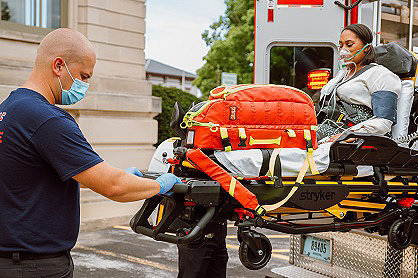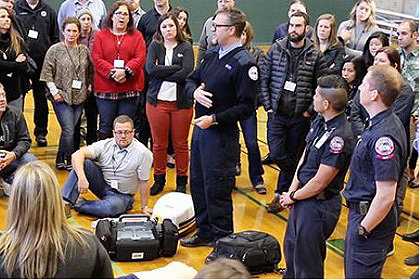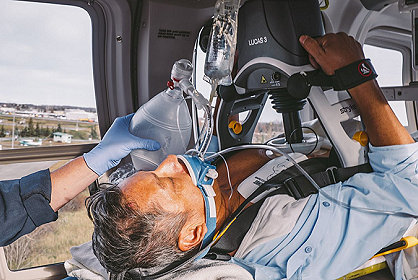Product resources
Find a variety of documents including best practices, datasheets and clinical information for easy download.
| HeartSine samaritan PAD |
Accessories catalog |
| LIFEPAK 1000 defibrillator | Accessories catalog |
| LIFEPAK 15 monitor/defibrillator | Accessories catalog |
| LIFEPAK 20/20e defibrillator/monitor | Accessories catalog |
| LIFEPAK CR Plus/EXPRESS | Accessories catalog |
| LIFEPAK CR2 AED | Accessories catalog |
| LUCAS chest compression system | Accessories catalog |
| CPR optimization - Driving perfusion during sudden cardiac arrest | Clinical study |
| SUNY ED No Falls Challenge | Quality Improvement Initiative Results in Successful No Falls Challenge in a Busy Emergency Department |
| University of Rochester Medical Center | LUCAS hospital case study |
| Forward Hearts Program | Donation details form |
| Forward Hearts Program | HeartSine customer event form |
| Forward Hearts Program | LIFEPAK customer event form |
| LIFEPAK 15 monitor/defibrillator | Performance evaluation - noninvasive pacing |
| LIFEPAK 15 monitor/defibrillator | Performance evaluation - noninvasive blood pressure |
| LIFEPAK 15 monitor/defibrillator | Performance evaluation - SpO2 |
| LIFEPAK 15 monitor/defibrillator | Performance evaluation - ECG monitoring |
| LIFEPAK 15 monitor/defibrillator | Performance evaluation - CO-MET |
| LIFEPAK 15 monitor/defibrillator | Performance evaluation - AED mode |
| LIFEPAK 15 monitor/defibrillator | Performance evaluation - synchronized cardioversion |
| LIFEPAK 15 monitor/defibrillator | Performance evaluation - 12-lead electrocardiogram |
| LIFEPAK 15 monitor/defibrillator | Performance evaluation - invasive Pressure |
| LIFEPAK 15 monitor/defibrillator | Performance evaluation - EtCO2 |
| LIFEPAK 15 monitor/defibrillator | Performance evaluation - manual defibrillation |
| LIFEPAK 20/20e defibrillator/monitor | Performance evaluation - Pulse oximetry (SpO2) |
| LIFEPAK 20/20e defibrillator/monitor | Performance evaluation - Noninvasive pacing |
| LIFEPAK 20/20e defibrillator/monitor | Performance evaluation - AED Mode with 2005 AHA guidelines |
| LIFEPAK 20/20e defibrillator/monitor | Performance evaluation - ECG with hands-free electrodes |
| LIFEPAK 20/20e defibrillator/monitor | Performance evaluation - Maintenance and Reports |
| LIFEPAK 20/20e defibrillator/monitor | Performance evaluation - ECG with paddles |
| LIFEPAK 20/20e defibrillator/monitor | Performance evaluation - AED Mode |
| LIFEPAK 20/20e defibrillator/monitor | Performance evaluation - EtCO2 with paddles |
| LUCAS 2 chest compression system | Performance evaluation checklist |
| LUCAS 3 chest compression system | Performance evaluation checklist |
| Discontinued products letter | January 2019 |
| Emergency Care | Customer guidance for cleaning COVID-19 |
| LIFEPAK 12 defibrillator/monitor | Service discontinuation letter, December 2018 |
| LIFEPAK 15 | V1-V2 service discontinuation customer letter |
| LIFEPAK CR Plus | Discontinuation customer letter |
| LIFEPAK 1000 defibrillator | Power options data sheet |
| LIFEPAK 1000 defibrillator | Data sheet |
| LIFEPAK 15 monitor/defibrilator | Data sheet |
| LIFEPAK CR2 AED | Data Sheet |
| LIFEPAK CR2 Trainer | Data Sheet |
| LUCAS 3, v3.1 chest compression system | Data Sheet |
| CODE-STAT 11 | Annotated CPR report |
| CODE-STAT 11 | Flyer |
| CODE-STAT System Recommendations | Flyer |
| CODE-STAT Why Upgrade | Flyer |
| Forward Hearts Program | Flyer |
| Its about time - when SCA strikes | Flyer |
| LIFENET AED Event Viewer | User guide |
| LIFENET By the Numbers | Flyer |
| LUCAS 3 chest compression system | System values flyer |
| LUCAS 3, v3.1 chest compression system | Myth Busted! LUCAS does fit large patients! fit guide |
| LUCAS chest compression system | Ventilation and defibrillation flyer |
| ProCare Service | LIFEPAK and LUCAS Hospital Plans |
| ProCare Service | LIFEPAK and LUCAS EMS Plans |
| Service Value Decoded | Flyer |
| LIFEPAK 1000 Non-rechargable battery | Instructions for use |
| LIFEPAK 1000 rechargable battery | Instructions for use |
| LIFEPAK 15 Lithium-ion battery | Operating instructions |
| LIFEPAK devices | Operating instructions |
| LUCAS device | Instructions for use |
| HeartSine AEDs | Product manuals |
| McGRATH MAC video laryngoscope | Instructions for use |
| Emergency preparedness for law enforcement | Brochure |
| Emergency Care ProCare Services brochure | ProCare Services brochure |
| LIFELINKcentral AED Program Manager | Brochure |
| LIFEPAK 1000 defibrillator | Product brochure |
| LIFEPAK 15 monitor/defibrilator | EMS product brochure |
| LIFEPAK 15 monitor/defibrillator | Hospital product brochure |
| LIFEPAK CR2 AED response system | Product brochure |
| LUCAS 3, v3.1 chest compression system | Brochure |
| LIFENET AED Event Viewer | User guide |
| LIFEPAK 15 monitor/defibrillator | Instructor's guide |
| LIFEPAK 20/20e defibrillator/monitor | Instructor's guide |
| LUCAS 3 chest compression system | Instructor guidebook |
| LUCAS 2 chest compression system | Performance evaluation checklist |
| LUCAS 3 chest compression system | Performance evaluation checklist |
| LUCAS 3 quick reference poster | LUCAS 3 quick reference poster |
| LUCAS 3, v3.1 chest compression system | Implementation guide |
| LUCAS 3, v3.1 chest compression system | Connectivity guide |

Training and education
Discover webinars, online and in-person courses and other resources to strengthen your clinical education.

Learning center
Learn. Understand. Implement. Enhance your product knowledge with online training.

LUCAS training
Theoretical and hands-on training for the LUCAS device. Test your knowledge and receive a certificate.
